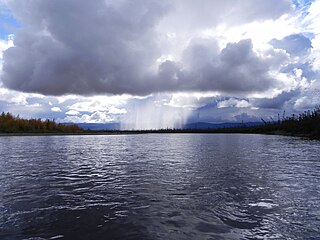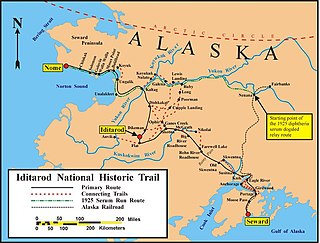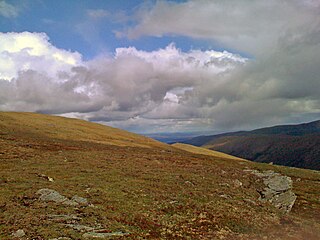
Eagle is a village on the south bank of the Yukon River, near the Canada–US border in the Southeast Fairbanks Census Area in Alaska, United States. It includes the Eagle Historic District, a U.S. National Historic Landmark. The population was 86 at the 2010 census. Every February, Eagle hosts a checkpoint for the long-distance Yukon Quest sled dog race.

The Iditarod Trail Sled Dog Race, more commonly known as The Iditarod, is an annual long-distance sled dog race held in Alaska in early March. It travels from Anchorage to Nome. Mushers and a team of between 12 and 16 dogs, of which at least 5 must be on the towline at the finish line, cover the distance in 8–15 days or more. The Iditarod began in 1973 as an event to test the best sled dog mushers and teams but evolved into today's highly competitive race.

A sled dog is a dog trained and used to pull a land vehicle in harness, most commonly a sled over snow.

Dawson City, officially the City of Dawson, is a town in the Canadian territory of Yukon. It is inseparably linked to the Klondike Gold Rush (1896–1899). Its population was 1,577 as of the 2021 census, making it the second-largest municipality in Yukon.

The Iditarod Trail, also known historically as the Seward-to-Nome Trail, is a thousand-plus mile (1,600 km) historic and contemporary trail system in the US state of Alaska. The trail began as a composite of trails established by Alaskan native peoples. Its route crossed several mountain ranges and valleys and passed through numerous historical settlements en route from Seward to Nome. The discovery of gold around Nome brought thousands of people over this route beginning in 1908. Roadhouses for people and dog barns sprang up every 20 or so miles. By 1918 World War I and the lack of 'gold fever' resulted in far less travel. The trail might have been forgotten except for the 1925 diphtheria outbreak in Nome. In one of the final great feats of dog sleds, twenty drivers and teams carried the life-saving serum 674 miles (1,085 km) in 127 hours. Today, the Iditarod Trail Sled Dog Race serves to commemorate the part the trail and its dog sleds played in the development of Alaska, and the route and a series of connecting trails have been designated Iditarod National Historic Trail.

The Yukon Quest, formally the Yukon Quest 1,000-mile International Sled Dog Race, is a sled dog race scheduled every February since 1984 between Fairbanks, Alaska, and Whitehorse, Yukon, switching directions each year. Because of the harsh winter conditions, difficult trail, and the limited support that competitors are allowed, it is considered the "most difficult sled dog race in the world", or even the "toughest race in the world"—"even tougher, more selective and less attention-seeking than the Iditarod Trail Sled Dog Race." The originator envisioned it as "a race so rugged that only purists would participate."

Birch Creek is a 150-mile (240 km) tributary of the Yukon River in the U.S. state of Alaska. Beginning at the confluence of Ptarmigan and Eagle creeks near Porcupine Dome, it flows southwest, then south under the Steese Highway and into the Steese National Conservation Area. It then turns east, then north, again passing under the Steese Highway and entering the Yukon Flats National Wildlife Refuge. Turning northwest, it ends where it splits into two distributaries, Lower Mouth Birch Creek and Upper Mouth Birch Creek, near Birch Creek, Alaska. The distributaries flow into the Yukon River at separate locations downstream of Fort Yukon.

The 1925 serum run to Nome, also known as the Great Race of Mercy and The Serum Run, was a transport of diphtheria antitoxin by dog sled relay across the US territory of Alaska by 20 mushers and about 150 sled dogs across 674 miles (1,085 km) in 5+1⁄2 days, saving the small town of Nome and the surrounding communities from a developing epidemic of diphtheria.

Yukon–Charley Rivers National Preserve is a United States national preserve located in east central Alaska along the border with Canada. Managed by the National Park Service, the preserve encompasses 130 miles (208 km) of the 1,800-mile (3,000 km) Yukon River and the entire Charley River basin. The preserve protects the undeveloped Charley River and a significant portion of the upper Yukon. The interior Alaskan region experiences extremes of weather, with temperatures that can vary from −50 °F (−46 °C) in winter to 97 °F (36 °C) in summertime. The Yukon provided a means of access to the region, which is entirely roadless, during the late 19th century and early 20th centuries. Gold rushes in Alaska brought prospectors, who operated gold dredges to recover significant quantities of placer gold from area creeks. Today the preserve includes part of the route of the annual Yukon Quest dogsled race, which runs every February. During the summer float trips are popular on the Yukon and Charley Rivers.
This article discusses transportation in the U.S. state of Alaska.

John Quniaq Baker is a self-employed American dog musher, pilot and motivational speaker of Inupiaq descent who once consistently placed in the top 10 during the long distance Iditarod Trail Sled Dog Race. Baker won the 2011 Iditarod with a finish time of 8 Days 19 Hours 46 Minutes 39 Seconds.

The Coal Creek Historic Mining District is a gold-mining area in the Yukon-Charley Rivers National Preserve of Alaska dating from the 1930s. It features a gold dredge and a supporting community of several dozen buildings, established by mining entrepreneur Ernest Patty.
Charlie Biederman was a musher in Alaska best known for being the last surviving dog sled mail carrier in the United States. Charlie was born in Alaska as the son of Ed Biederman, a musher born in Bohemia who immigrated to the United States in 1874 and also delivered the mail via dog sled. The date of Charlie's birth is unclear, but contemporary U.S. Censuses indicate it likely was around 1919. Charlie had four siblings. Charlie was raised in Eagle, Alaska, but lived in an isolated cabin on the Yukon River for most of his life. From an early age, he assisted his father and brother in their winter deliveries of the mail to isolated cabins in central Alaska. In winter, the family lived in Eagle and ran the mail route between that town and Circle, another small settlement approximately 158 miles (254 km) downriver. In the summer, the family lived at their Yukon River cabin, harvesting fish for subsistence and boarding the dogs of fellow mushers. In 1938, the family were underbid for the main contract for mail delivery in the area by a bush pilot. Ed Biederman retired shortly afterward and died in 1945. The final dog sled mail route was replaced in 1963. That final route was from Gambell to Savoonga and was run by Chester Noongwook. In January 1995, he donated the mail-delivery sled he used to the National Postal Museum in Washington, D.C., where it hangs today. One month after making the delivery, he died on February 22, 1995.

Eagle Summit is a 3,652 feet (1,113 m)-tall gap through the White Mountains of central Alaska. The gap was named after the nearby Eagle River by prospectors from nearby Circle, Alaska.

Slaven's Cabin, also called Slaven's Roadhouse and Frank Slaven Roadhouse, is a public-use facility in the Yukon-Charley Rivers National Preserve in Alaska. The cabin is located on the Yukon River, 42 miles (68 km) southeast of Circle, Alaska, and 138 miles (222 km) northeast of Fairbanks, Alaska. It is listed on the National Register of Historic Places.
Trout Creek is a small tributary of the Yukon River in the U.S. state of Alaska. It is about 11 miles (18 km) long and is located about 27 miles (43 km) northwest of the town of Eagle. In winter, a small cabin at the creek's mouth is a hospitality stop for the Yukon Quest sled dog race.

The George McGregor Cabin on the Yukon River, about two miles downstream from Coal Creek, in the Yukon-Charley Rivers National Preserve of Alaska is a historic Log cabin built in 1938 that was listed on the U.S. National Register of Historic Places in 1987.

The Woodchopper Roadhouse, on the Yukon River, is a historic establishment that was built in approximately 1910. It is located in the Yukon-Charley Rivers National Preserve. It served as a hotel and as a post office. Its log building was listed on the National Register of Historic Places in 1987.


















